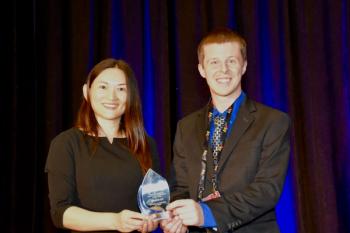
William F. Meggers Award Presented to S. Michael Angel of the University of South Carolina
The William F. Meggers award is presented to the author or authors of an outstanding paper appearing in Applied Spectroscopy. This year’s recipient is S. Michael Angel, a professor of chemistry at the University of South Carolina (Columbia, South Carolina).
The William F. Meggers award is presented to the author or authors of an outstanding paper appearing in Applied Spectroscopy. This year’s recipient is S. Michael Angel, a professor of chemistry at the University of South Carolina (Columbia, South Carolina). Angel received the award at the SciX 2018 conference, which was held October 21–26 in Atlanta, Georgia. Also receiving the award were Patrick D. Barnett, Nirmal Lamsal, Kelly C. Paul, and K. Alicia Strange Fessler, members of Angel’s group who collaborated with Angel on five related papers on the topic of spatial heterodyne spectroscopy applied for Raman and laser induced breakdown (LIBS) spectroscopy in 2017. This is the first time that the award has been presented for a group of papers, rather than a single publication.
Angel has held the Fred M. Weissman Palmetto Chair in Chemical Ecology since 2005 and was named a Carolina Trustee Professor in 2013. He received his PhD from North Carolina State University (Raleigh, North Carolina) in 1985 and did his postdoctoral work with Tomas Hirschfeld at Lawrence Livermore National Library (Livermore, California).
The main focus of Angel’s research group is in the areas of remote and in-situ laser spectroscopy with a focus on deep-ocean planetary and homeland security applications of Raman and LIBS. His recent work includes developing the spatial heterodyne Raman spectrometer, which was awarded the 2012 Meggers Award, and exploring the use of spatial heterodyne Raman spectroscopy for deep UV Raman, remote Raman, and for use on future planetary landers and small satellites.
Barnett received his PhD in analytical chemistry in Angel’s group at the University of South Carolina (in 2016. His graduate research focused on the development of a miniature spatial heterodyne spectrometer for Raman spectroscopy, and LIBS for planetary exploration and other extreme environments. He is now conducting post-doctoral research at Sandia National Laboratories, in the Advanced Remote Sensing group.
Lamsal received his PhD in Analytical Chemistry under the supervision of Angel at the University of South Carolina. His PhD research focused on designing and constructing a the spatial heterodyne Raman spectrometer for standoff measurements. Currently, he works at ChemImage Corporation in Pittsburgh, Pennsylvania.
Paul earned her B.S. degree in chemistry from the University of South Carolina in 2015. She completed an extended undergraduate research project with Angel, focusing primarily on Raman spectroscopy. She currently works in the polymer analytical laboratory of the Shakespeare Company LLC, a division of Newell Brands,
Strange received her PhD from the University of South Carolina in 2016. Her research conducted under Angel characterized and demonstrated standoff and 1-D imaging using the visible spatial heterodyne Raman spectrometer for the detection of solids and solutions related to planetary exploration and high explosives applications. She is now a senior scientist in the analytical development division at Savannah River National Laboratory.
Newsletter
Get essential updates on the latest spectroscopy technologies, regulatory standards, and best practices—subscribe today to Spectroscopy.




